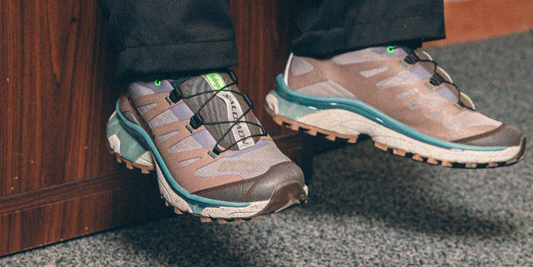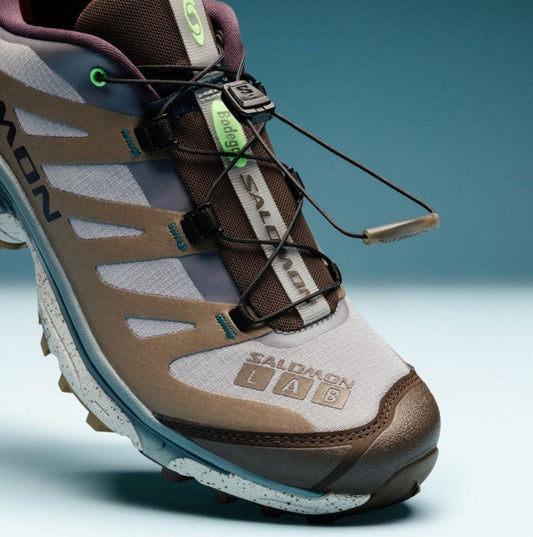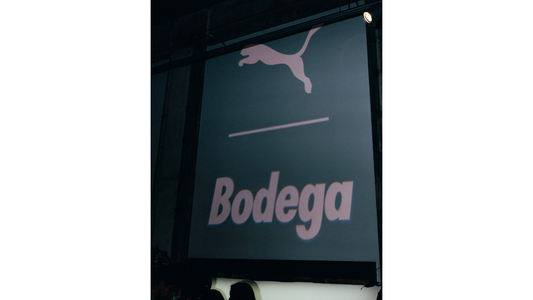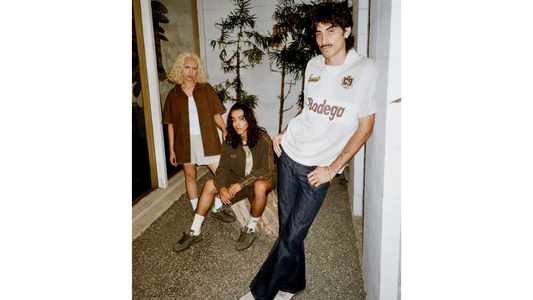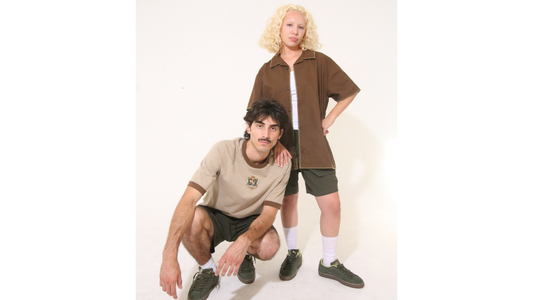When you’ve actually lived through something the first time around, seeing it come back as retro fashion can be disorienting. It’s like watching a movie that you’ve seen dozen of times, that you can recite entire passages from, by memory, with someone who has never seen it. It leaves you trying not to react to something you already know is coming. That being said, fashion doesn’t require spoiler alerts, so it’s perfectly acceptable to say that there are a lot of 90s children waiting for the moment when the hockey jersey is officially back.
Like a lot of other things that caught on during the 90s, there was a major element of youth and breaking with the cultural status quo in the sudden hockey explosion. Before the sport’s surge in popularity, it had been considered a decidedly niche interest. Outside of traditional hockey markets, the 1980 Olympics Miracle On Ice and the old Rodney Dangerfield joke about going to the fights and a hockey game breaking out represented the major points of reference for the average person. But, developments on and off the ice converged to take the sport out of the realm of well-kept secrets.
The 1990s represented the high water mark of hockey’s popularity in American popular culture, and with the colorful, synthetic mesh knit poised to make a triumphant return, it seems like a good time to take a look back at some of the key moments behind hockey’s rise to genuine part of the mainstream sports landscape.
Fighting: It has to be said that, in all fairness, hockey’s old reputation as an ice bound bastion of gladiatorial combat is not entirely as mystifying as some of its most fervent enthusiasts would have you believe. Yes, the game has been graced by players of breathtaking skill, dating back to its organizational infancy, and fighting is only a part of a larger whole, but for the uninitiated, it could tend to be a bit overwhelming. Trying to come to grips with the rules and structure of a sport, while simultaneously trying to make sense of something like a late 80s, Norris Division pitched battle wasn’t something that was quite ready for prime time.
In response to a particularly ridiculous melee, sparked by a Claude Lemieux warm-up ritual of shooting a puck into the opposing team’s empty net, prior to a conference final game between the Philadelphia Flyers and the Montreal Canadiens, the NHL finally stepped in. The age of bench clearing brawls was brought to end that summer by the newly instituted rule 70.1, which penalized players who left the bench to enter a fight with a 10-game suspension and maximum $10,000 fine. The rule also allowed for coaches who “lost control” of the bench in such situations to be fined. Curbing the free for all excesses and restoring the occasional fight as a somewhat taboo but scintillating novelty, rather than the main event, made for an altogether more palatable product for television.
The Gretzky Trade: The Edmonton Oilers finished the 1987-88 season with their fourth Stanley Cup in five seasons, after easily dispatching the Boston Bruins. That summer, Edmonton owner Peter Pocklington shocked the hockey universe by shipping national treasure and best player on Earth, Wayne Gretzky, to the Los Angeles Kings.
While outrage radiated from its central Alberta epicenter across all of Canada, the Great One’s arrival in Hollywood proved to have a seismic impact on the future of the game. With a spiffy, new, Raiders adjacent, silver and black set of uniforms to go along with a newly minted contending team, celebrities like Tom Hanks, John Candy, Kurt Russell and Goldie Hawn became Forum regulars. Even though the Kings had been around since 1967, the enthusiasm generated by Gretzky was perhaps the first time that hockey became cool, in a nontraditional market. Ultimately, the reverberations extended far beyond L.A. and the Kings. The L.A. success proved to be the launching point for warm weather hockey, extending the NHL’s reach from regional specialty to a truly national operation.
Shark Attack: The NHL’s push into more temperate climes included the placement of an expansion franchise in the Bay Area. It would take a few years before the San Jose Sharks would achieve anything noteworthy on the ice, but the team made an immediate impact on merchandise sales. The ‘pacific teal’ based color scheme and the iconic logo portraying a shark biting a hockey stick in two simply had it all. It was aggressive and sleek, it was fashionable, and it was new. In terms of reaching an audience outside of existing hockey fans, the Sharks may have surpassed even the Gretzky led Kings. You had to be in Los Angeles to actually experience a Kings game; you could buy a Sharks hat or jacket anywhere, which a lot of people did. Those things were everywhere. People who had ever seen one minute of a hockey game were sporting Sharks gear. If there’s a single moment when the whole hockey jersey trend was kickstarted into life, it was the first time Sharks merch hit stores.
Mighty Ducks: California’s still had more influence to exert over the game of. Writer Steve Brill and director Peter Berg caught the hockey bug, and the fruits of their labor, The Mighty Ducks, would hit movie theatre screens on October 2, 1992. While far from critically acclaimed, the movie was a huge hit with its intended target audience, kids, to the point of spawning two sequels. Not to mention that Disney bought an expansion franchise, and named it after the movie. Perhaps the greatest legacy of the series is the number of kids spurred to pick up a hockey stick in real life after seeing the movies. The amount of man-hours lost by 90s kids trying to recreate the triple deke or the physically impossible in real life knucklepuck is countless, and something that can’t be measured with critical star ratings.
Snoop Dogg: From family films to an arena of the entertainment industry more likely to come with parental advisory stickers, the adoption of hockey jerseys by rappers was an integral factor in boosting the sport’s cultural aura. Standouts include Tupac’s Red Wings jersey, and Snoop Dogg sporting the Penguins’ redesigned road jersey, with the diagonal “Pittsburgh” script. If there were any doubts as to how much influence this particular form of exposure merited, the Springfield Indians quickly allayed them. The American Hockey League affiliate of the Hartford Whalers became the most famous team in possibly the history of minor league hockey, after Snoop Dogg gave their jersey an airing in the Gin and Juice video. With a link to modern youth culture firmly established, it was all systems go for the hockey jersey, now available from major leisurewear fashion labels of the era like Polo, Tommy Hilfiger and Nautica.
If it’s in the game: The early 90s introduction of second generation, 16-bit game consoles helped to boost hockey’s popularity by hosting arguably the two finest hockey video games ever produced, NHLPA ’93, and NHL ’94. The mix of immersive detail (NHL 94 included team specific organ music for every franchise!) and addictive gameplay made these titles the stuff of absolute legend. It helped that hockey seemed to translate to the video game arena more effectively than other sports. Baseball and basketball, unless you were a fan, were a bit too slow for casual gaming, and the complicated formations and play calling of football wasn’t going to attract the attention of novices. On the other hand, anyone could grasp simple concepts like, blasting a slap shot as soon as you cross the blue line in ’93 or drawing the defense towards the puck carrier and passing to the open man streaking in for a one-timer in ’94. In fact, veterans of these games will share similar stories of instituting unofficial bans on certain moves, like the aforementioned methods, because they resulted in automatic goals every time. Even now, it’s tempting to abandon this whole project to fire up the Super Nintendo and play as the Whalers, just to hear Brass Bonanza.
1940 Is History: What really put the NHL over the top, in terms of mainstream popularity, was that all these tangential factors converged with one of the greatest, on- ice seasons ever, most especially the playoffs, where the now or never roster assembled by the Rangers set out to end a 54 year Stanley Cup drought.
The first round alone saw the Sharks, a team in its third season of existence, who had made the playoffs for the first time, with a 5’8 Latvian goalie, knock off the number 1 seeded Detroit Red Wings, for starters. Two different goaltending duels between four of the best goalies in the world. One pitted the New Jersey Devils and their rookie sensation Martin Brodeur against the Buffalo Sabres and their obscure backup turned unbeatable dominator, Dominik Hasek, the other had the Blackhawks and elite goalie Ed Belfour take on the Maple Leafs and elite goalie Felix Potvin. Between the two series there were five shutouts, four of them 1-0 scorelines and three games decided by overtime, including a four overtime marathon in Buffalo, as New Jersey and Toronto advanced. Perhaps the most thrilling moment of the first round came in the prime time TV unfriendly locales of western Canada, as the Vancouver Canucks overturned a 3-1 series deficit against the Calgary Flames by winning three consecutive overtime games. Game 7 was decided by one of the most electrifying players in the game, the Russian Rocket Pavel Bure, scoring on a breakaway in double overtime.
All the excitement of the opening round was just to set the stage for the conclusion, which just happened to be some of the most dramatic and compelling playoff hockey ever played. The Canucks path to the finals turned out to be surprisingly straightforward, they dispatched the Stars and Maple Leafs without complications. The Rangers, on the other hand, made up for easy victories over the Islanders and Capitals by making their fans suffer through every individual second of the Conference Finals and Stanley Cup Finals.
The Rangers found their path blocked by intense local rivals, and a seriously good team to boot, the New Jersey Devils. A rivalry fueled by the axiom that familiarity breeds contempt generally doesn’t require any extra motivation, but with a trip to the Stanley Cup Finals on the line, this Rangers Devils matchup was just about a matter of life and death. The series was back and forth the whole way, but the Devils put the Rangers on the brink of elimination with a 4-1, game 5 win in New York. What happened next is immortalized in New York sports lore. First, the Rangers needed to win in hostile territory just to stay alive, which captain Mark Messier was confident enough of to guarantee in print. Messier made good on his promise with a third period hat trick to overturn a 2-1 deficit and force a game 7 at Madison Square Garden. Game 7 was even harder on the hearts of the tri-state area, as the 1-0 the Rangers clung to for just over half the game was wiped out with 7.7 seconds left to play. Fans were kept on the edge of their seats until the wee hours of the morning, when a deceptive Stephane Matteau wraparound snuck past Martin Brodeur and put the Rangers in the finals.
If there was any danger of a letdown after such a cathartic victory over their local rivals, the Rangers didn’t show it, as they raced out to a 3-1 series lead over the Vancouver Canucks. With fans just about ready to pop some seriously pent up champagne corks, they dropped the next two games, meaning everything would come down to a deciding game 7 in New York. Again, the Rangers took an early lead, before allowing the Canucks to close the gap, but 3-2 would be as close as they got. A banner in the stands read “now I can die in peace,” which says it all really.
The 1993-94 season afforded the NHL a unique opportunity to cement their growing popularity. While hockey’s status was obviously boosted, the league fell short of taking full advantage. At the conclusion of the 1994 playoffs, Sports Illustrated ran a cover with the headline “10 Reasons why the NHL’s Hot and the NBA’s not.” In the first full season following Michael Jordan’s initial retirement, the league seemed short on marquee star power, and long on an unglamorous, combative style of play, but instead of seizing on the momentum, newly created fans eager for their next fix of on-ice action were greeted by a player lockout that wiped out more than half the season. It was late January 1995 before the new NHL season got started, and in the middle of the abbreviated schedule, Michael Jordan decided he wanted to play basketball after all. It’s not like the NHL fell off the face of the Earth, but the moment had passed.
When the hockey jersey finally does get the full fledged fashion revival treatment, just try to remember to look up some old highlights on YouTube or something. It won’t just give you a deeper understanding of the clothes, you might actually find yourself wanting to watch an entire game too.


